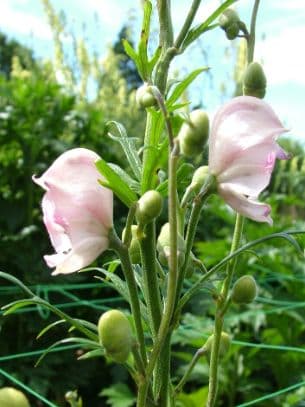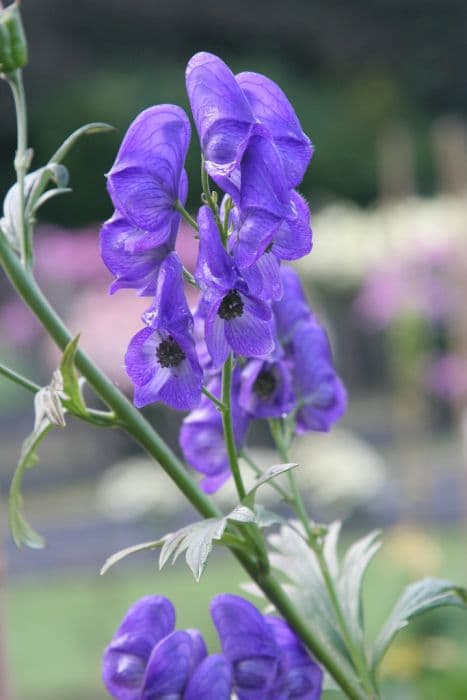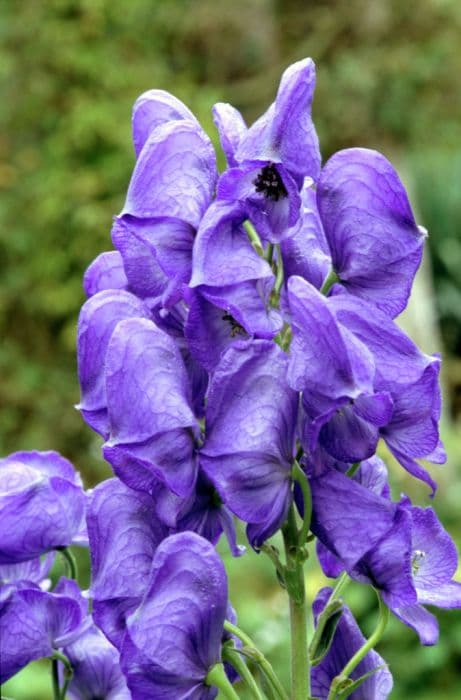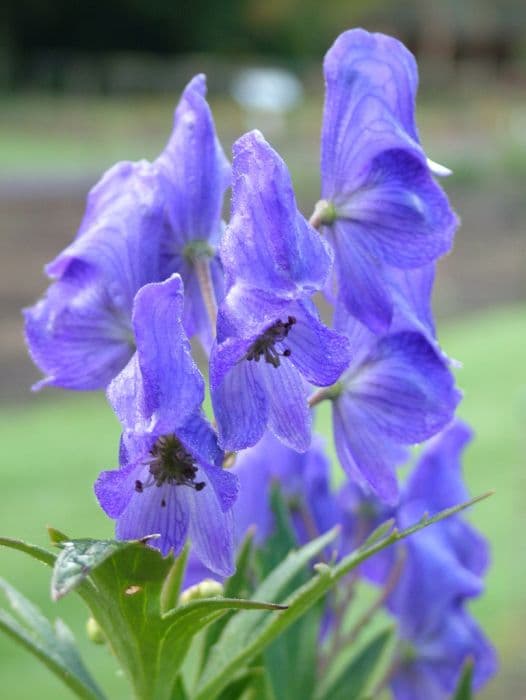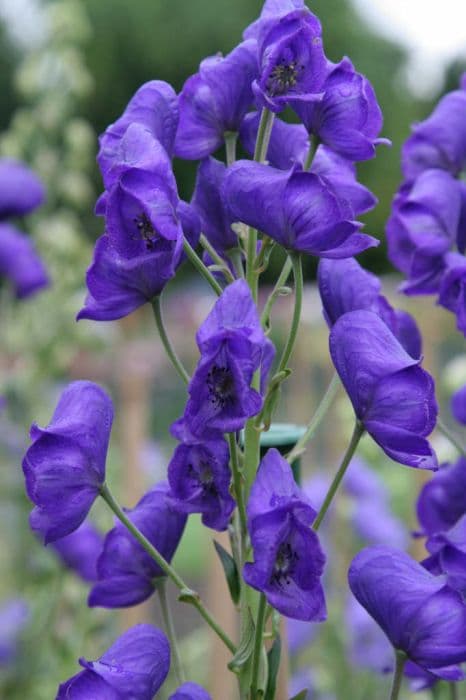Clematis Marjorie Clematis 'Marjorie' (M/d)

ABOUT
Clematis 'Marjorie' is a unique, ornamental plant noted for its distinct semi-double flowers. The blooms are an attractive salmon-pink hue, often with a more intense pink bar at the center of each sepal, creating an eye-catching contrast and depth in the flower's appearance. These sepals are long, slightly wavy, and tend to have a rounded shape with somewhat ruffled edges that add to the textural interest of the plant. Displaying a generous bloom period, Clematis 'Marjorie' produces flowers in abundance, which emerge from slender, curling buds. As the plant matures throughout the season, the flowers tend to become more of a simple, open form, displaying their creamy-yellow stamens in the center, which stand out against the pink petals and attract pollinators. The leaves of the Clematis 'Marjorie' are medium to dark green, compound, and often consist of multiple leaflets that are ovate with pointed tips. The foliage provides a lush backdrop for the striking flowers, which are the main attraction of the plant. The leaves are arranged alternately along the stems, providing a well-distributed greenery that complements the floral display. Beyond its blooming period, Clematis 'Marjorie' continues to offer visual interest with its fluffy seed heads that follow the flowers, giving the plant a delicate, almost whimsical appearance that persists even as the seasons change. Overall, Clematis 'Marjorie' is prized for its profusion of unique blooms that continue to evolve in appearance throughout the growing season, making it a standout addition to garden spaces, where it often climbs up trellises, fences, or other supports, adding vertical interest and a splash of warm color.
About this plant
 Names
NamesFamily
Ranunculaceae
Synonyms
Marjorie Clematis
Common names
Clematis 'Marjorie'
 Toxicity
ToxicityTo humans
Clematis, including the 'Marjorie' variety, is considered to be mildly toxic if ingested. The plant contains irritating glycosides which can cause symptoms such as nausea, vomiting, diarrhea, and salivation. Skin contact with the sap may result in redness, itching, or a rash in sensitive individuals. Ingesting large quantities could potentially lead to more severe symptoms, though such cases are rare.
To pets
Clematis, commonly referred to by this name for all varieties including 'Marjorie', is toxic to pets if ingested. It contains irritant glycosides that can cause drooling, vomiting, and diarrhea. In some cases, ingestion of clematis may also cause excessive salivation and mouth ulcers. Signs of poisoning often appear within a few hours and may require veterinary attention, especially if large amounts of the plant have been consumed.
 Characteristics
CharacteristicsLife cycle
Perennials
Foliage type
Deciduous
Color of leaves
Green
Flower color
Mixed
Height
6 feet (1.8 meters)
Spread
3 feet (0.9 meters)
Plant type
Climber
Hardiness zones
4
Native area
Asia
Benefits
 General Benefits
General Benefits- Decorative Appeal: Clematis 'Marjorie' produces abundant salmon-pink blooms which add a pop of color and aesthetic appeal to gardens and landscapes.
- Vertical Gardening: This climber is perfect for vertical gardening, enabling gardeners to make the most of limited space by growing upwards on trellises, fences, and walls.
- Seasonal Interest: It blooms from spring to early summer, offering seasonal interest and variety throughout its blooming period.
- Wildlife Attraction: The flowers attract pollinators such as bees, butterflies, and other beneficial insects to the garden, promoting biodiversity.
- Versatility: Suitable for various garden styles including cottage gardens, urban gardens, and container gardening when provided with a structure to climb on.
- Easy Pruning: Belonging to pruning group 2, Clematis 'Marjorie' requires minimal pruning, just a light trim after the first flush of flowers to encourage new growth and more blooms.
- Hardiness: It is relatively hardy and can withstand cold temperatures, which makes it suitable for growth in a variety of climates.
 Medical Properties
Medical PropertiesThis plant is not used for medical purposes.
 Air-purifying Qualities
Air-purifying QualitiesThis plant is not specifically known for air purifying qualities.
 Other Uses
Other Uses- Clematis 'Marjorie' can be used in weaving and basketry; the flexible stems can be harvested and woven into various decorative objects or functional items like baskets.
- The vine's sturdy stems can serve as natural ties in the garden for staking other plants or creating living structures when trained over frames.
- Clematis 'Marjorie' can be used in floral arrangements; the vine’s flowers and foliage add a rustic charm to bouquets or table centerpieces.
- The plant can also be incorporated into educational projects for children, teaching them about plant growth and training vines.
- Those into crafting might use dried Clematis 'Marjorie' flowers for creating natural dyes for fabrics or papers.
- Garden designers often use Clematis 'Marjorie' for creating green curtains on walls or fences, providing a visual screen with its foliage and blooms.
- In artistic photography, the striking flowers of Clematis 'Marjorie' can be used as a subject or backdrop, particularly in macro photography.
- The plant can be trained to grow over unsightly features in a garden, such as compost bins or utility boxes, camouflaging them with its abundant flowers.
- Clematis 'Marjorie' can also be used in erosion control, as its dense root system can help stabilize soil on slopes or banks.
- Enthusiasts of upcycling might use pruned Clematis 'Marjorie' stems to create eco-friendly jewelry or decorative items for the home.
Interesting Facts
 Feng Shui
Feng ShuiClematis is not used in Feng Shui practice.
 Zodiac Sign Compitability
Zodiac Sign CompitabilityClematis is not used in astrology practice.
 Plant Symbolism
Plant Symbolism- Mental Agility: Clematis flowers are known for their ability to climb and adapt to their surroundings, which can symbolize the ability to navigate through mental challenges with ease and flexibility.
- Creative Inspiration: The distinctive appearance of the Clematis 'Marjorie', with its multi-petaled form, often represents a burst of creativity or the blooming of ideas.
- Spiritual Ascent: Just as the Clematis vine climbs towards the light, this flower can also be a symbol of spiritual growth and the quest for higher knowledge.
- Beauty and Joy: With its vibrant colors and lush appearance, the Clematis is often associated with the enjoyment of life's beauty and the presence of joy.
- Resilience: The ability of Clematis 'Marjorie' to thrive in various conditions is seen as a representation of resilience and the strength to overcome life's obstacles.
 Water
WaterThe Clematis 'Marjorie', commonly known as the Marjorie Clematis, requires watering that ensures the soil is consistently moist but not waterlogged. During the growing season, water the plant deeply once a week with about 1 gallon of water, adjusting this frequency during periods of drought or excessive rainfall. Ensure that the soil is well-draining to prevent root rot. In the winter, when the plant is dormant, reduce watering but do not let the soil completely dry out.
 Light
LightThe best light conditions for the Marjorie Clematis is a spot where it can receive around 6 hours of sunlight a day, ideally in the morning with some shade in the intense afternoon sun. This plant thrives in partial shade or dappled sunlight, particularly in the hotter parts of the day, which helps protect the flowers from fading or scorching.
 Temperature
TemperatureThe Marjorie Clematis performs best in temperate climates and can tolerate temperatures between 20°F and 85°F. It requires a period of cold dormancy, so winter temperatures around the freezing point are beneficial. The ideal growing temperature range during the spring and summer is between 55°F and 70°F to promote healthy growth and blooming.
 Pruning
PruningThe Marjorie Clematis benefits from pruning to promote vigorous growth and enhance flowering. Prune in late winter or early spring before new growth begins by cutting back the previous year's stems to a pair of strong buds about 1 foot above the ground. Additionally, it helps to remove any dead or weak stems after blooming to maintain plant health and appearance.
 Cleaning
CleaningAs needed
 Soil
SoilThe Clematis 'Marjorie' prefers well-draining soil enriched with compost or well-rotted manure. The ideal soil pH for Clematis 'Marjorie' is slightly alkaline, between 7.0 and 7.5. A good mixture would be two parts loamy soil, one part compost, and part perlite or coarse sand to promote drainage.
 Repotting
RepottingClematis 'Marjorie' typically requires repotting every 2-3 years, depending on its growth rate and the size of the container. It's best repotted in spring before the onset of the new growing season.
 Humidity & Misting
Humidity & MistingClematis 'Marjorie' tolerates average garden humidity levels well. While it is adaptable, ideally, the humidity should range from 50% to 70% for optimal growth.
 Suitable locations
Suitable locationsIndoor
Ensure bright, indirect light and cool feet for indoor Clematis 'Marjorie'.
Outdoor
Plant in sun or part shade, keep roots cool with mulch or shade for outdoor growth.
Hardiness zone
4-9 USDA
 Life cycle
Life cycleClematis 'Marjorie' begins its life cycle when the seeds germinate in spring after experiencing a period of cold stratification, which breaks dormancy. The seedlings develop into juvenile plants, putting forth a small number of leaves and establishing a root system. As it matures, Clematis 'Marjorie' climbs using its leaf petioles to grasp onto supports, developing woody stems and producing its distinct, salmon-pink, semi-double flowers in early to mid-summer. After the blooming period, it may produce more flowers, but these will typically be simpler, single flowers. The plant then forms feathery seed heads that eventually release seeds, completing the reproductive stage. Finally, as autumn approaches, Clematis 'Marjorie' enters a dormant phase, retreating back to its permanent framework of woody stems until conditions are favorable for the next growing season.
 Propogation
PropogationPropogation time
Spring-Early Summer
Propogation: The Clematis 'Marjorie', known for its abundant salmon-pink blooms, is commonly propagated through semi-hardwood cuttings. The ideal time for propagation is during midsummer when the plant is actively growing. A semi-hardwood cutting involves selecting a portion of the stem that is not overly mature and yet not too soft. A good cutting typically measures about 4 to 6 inches (10 to 15 centimeters) in length and includes several sets of leaves. After cutting, the lower leaves are removed and the base is dipped in a rooting hormone to encourage growth. The cutting is then planted in a well-draining propagation medium. Keeping the soil moist but not waterlogged, and providing indirect light, can create an ideal condition for the cutting to develop roots over several weeks.

